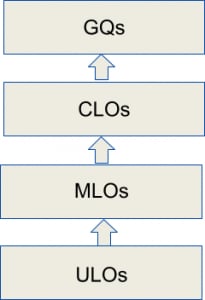Curriculum mapping involves tracing the connections between the learning outcomes, activities, and assessments in each unit of study to the outcomes for students graduating in the courses to which the units contribute. In ‘traditional’ or direct mapping, unit coordinators write learning outcomes for their subjects and then indicate how these relate to the course outcomes and to the graduate qualities. In many courses, especially those with professional accreditation requirements, unit coordinators may also show how each of their learning outcomes relate to external standards. One problem with this approach is that it may be difficult for a unit coordinator and can encourage a ‘tick-box’ approach. This can a real problem for graduate qualities since these are written to cover all courses and are necessarily general and abstract. In addition, many units contribute to multiple courses.
Sydney’s approach
In indirect or derived mapping, the approach is reversed. Course (i.e. degree) coordinators first add disciplinary context to the graduate qualities to write course outcomes. In courses made up of distinct parts or components, such as streams, programs and majors, component coordinators further contextualise these by writing outcomes for their components. Finally, the unit coordinator writes subject level outcomes describing how some of these are developed in their unit. The coordinator of the Bachelor of Science, for example, writes outcomes to show how a science graduate will obtain the graduate qualities. The coordinator of the chemistry major then writes outcomes describing how the discipline delivers the science outcomes. The coordinator of a first year chemistry unit then writes learning outcomes describing how some of these are developed and assessed in the activities of the unit. The full process is outlined below.
Graduate qualities (GQs)
These are the University’s statements on the desired outcomes for students at the end of their degrees and encompasses the “uniqueness” of a Sydney graduate. As they need to describe the outcomes of student for every course, their definitions are necessarily broad and abstract.
Course learning outcomes (CLOs)
CLOs are statements on the desired degree outcomes and the unique approach at Sydney to these. They contextualise the graduate qualities for this approach and give meaning for teaching staff and students to the abstract graduate qualities at the degree level. The course coordinator writes the CLOs and shows alignment to graduate qualities.
Component or mid-level learning outcomes (MLOs)
MLOs are statements on the desired disciplinary outcomes and its unique approach. They further contextualise the CLOs for the discipline approach and give additional disciplinary meaning for staff and students. The component coordinator* writes the MLOs. The course coordinator shows how they align to the CLOs.
Unit learning outcomes (ULOs)
ULOs are statements on the desired subject outcomes. They explain how some (or all) of the MLOs will be developed in the learning tasks that the student will undertake. The unit coordinator writes the ULOs. The component coordinator shows their alignment to the MLOs*.
*For courses which do not have components, the MLO step is missed off and the course coordinator maps the unit learning outcomes directly to those for the course.
Some examples of how this works in practice are available on the Sydney Curriculum Canvas site.






